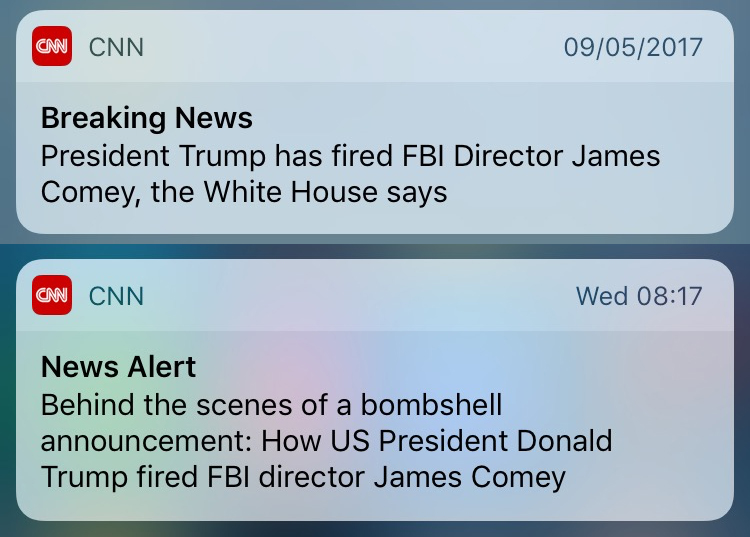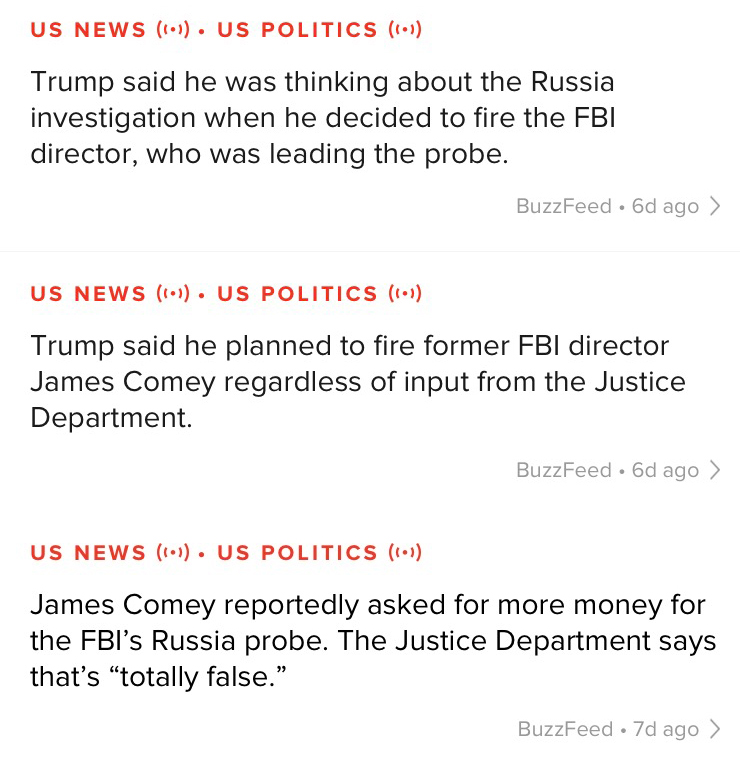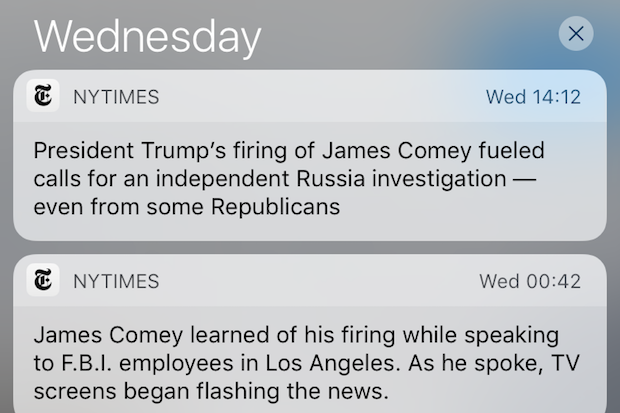President Trump's firing of FBI director James Comey has been making headlines since 9 May, when the White House published a statement citing the president's decision, and the ramifications of this event have kept news organisations and readers' lock screens busy ever since.
At least once a day over the last week, if not more frequently, news outlets have been alerting audiences to new developments in the story.
With so many updates, conflicting statements and key figures involved, it can be tricky for readers, even those with prior knowledge of Comey and his prominence in the 2016 US election, to keep track of what was happening, or to become interested in the news in the first place.
Here's an overview of how The New York Times, CNN and BuzzFeed News applied their push notification strategy to this story, including how many alerts they sent, the type of coverage they pushed and the language and context they used.
The New York Times
The news of the firing broke late in the day, and NYT sent three alerts the night of the event, said Eric Bishop, assistant editor for mobile.
The first one alerted to the firing, while the second brought in more context by mentioning the White House's initial explanation that the decision was related to Comey's actions in relation to Hillary Clinton's emails. The third alert painted the picture of how the FBI director learned of his firing – "while speaking to FBI employees in Los Angeles. As he spoke, TV screens began flashing the news", it said.
The day after, three more push notifications made their way to readers' lock screens. One featured NYT's exclusive that James Comey had asked the Justice Department for more resources in the FBI investigation into Russia's involvement in Trump's presidential campaign.
"The other two alerts were a bit more about enterprise reporting, sort of features coming off the news – one was about the Republican's reaction and the other about how the decision to fire him went down inside the White House," Bishop told Journalism.co.uk.

In total, The New York Times had sent 16 push alerts at the time of our interview with Bishop: five were breaking news alerts, which are sent to every reader using NYT's app; four were sent to the app's 'top stories' channel for features and non-breaking news; five were sent to the 'politics' channel, and two were pushed through Apple News, including a comprehensive article looking at Comey's actions during the election.
The team also pushed an opinion piece in the form of a letter written by the editorial board to the US deputy attorney general in the wake of the firing, which is something "we rarely do".
Bishop pointed out that with a limited number of characters available, prioritising what to include is a main consideration. The outlet did not include Comey's title in each alert, for example.
"There's also a question of follow up alerts, so how much knowledge do we assume from the reader? Do we need to explain who Comey is in every alert?"
The first notification NYT sent broke the news but also included some context: "President Trump has fired James Comey, the FBI director. A White House statement said he did so on Jeff Session's recommendation," the alert read.
"That was the only bit of context we had at the time but we felt it was important to include in the alert," Bishop added.
"We try to provide context in every alert we send and we also strive to use all the available space, because we have to make every word count to help the reader understand the significance of the story."
The New York Times also sent out a double push alert on Tuesday (16 May) to its scoop that President Trump had requested Comey to stop the investigation into former national security adviser Michael Flynn. You can read more about the decision to push two consecutive alerts in this Nieman Lab piece.
CNN
CNN sent a total of 11 alerts between 9 and 16 May. The first one, "President Trump has fired FBI Director James Comey, the White House says", was a "standard, OMG alert", said Matt Wells, senior editor, programming, CNN International Digital.
Wells oversees the team at CNN tasked with homepage and app editing and alerts for the organisation's international audience, which is a separate group to the one sending push alerts to the US audience. Segmenting the audience is useful because the team in the US "will sometimes alert more frequently and sometimes assume more knowledge from readers" compared to the international team, he explained.
CNN app users can opt to receive top news alerts, standard (what most people sign up for), or all the alerts sent by the organisation. Out of the 11 notifications sent, nine were to the standard category, "which shows this is a story that we pushed quite vigorously to our audience and it was dominant for the CNN International audience last week".
"Much of our audience would've been asleep when the news happened, so the next morning we sent out another and I remember thinking that we wanted to push to our audience some of our best background and contextual material."
This included an alert on "Behind the scenes of a bombshell announcement: How US President Donald Trump fired FBI Director James Comey", which Wells pointed out wasn't a standard alert that CNN would have sent a year ago.

"It's quite a feature-y alert, it's alerting to a background story. I think news alerts have evolved considerably in the last year, from being just about breaking news to providing more background, context and analysis."
For an international audience, CNN tries to avoid assuming that audiences know or remember who the people involved in a particular story are, so both President Trump and James Comey received their titles alongside their names in the alerts.
"When you're writing an alert you have to bear in mind that people might not come to you and read further, so they are self-contained stories.
"At CNN we are relaxed about where people get their news, but I think organisations have realised that if they do want to bring audience back to their site, the kinds of stories people will come to you for might be the more distinctive journalism and stand-out analysis or a great op-ed."
BuzzFeed News
Claire Moses, editor, mobile, at BuzzFeed News, also pointed out that assuming knowledge from readers is dangerous, even when writing for people in the US or wherever the story happens.
"You need to say 'FBI director James Comey' as opposed to just 'James Comey', especially if you're sending to an audience spread out around the world," she said.
BuzzFeed News sent a total of nine alerts, including one about President Trump disclosing highly classified information to Russian officials on 16 May.

The BuzzFeed News app also allows users to choose which categories they receive alerts from, including to opt out of breaking stories, so updates about Comey's firing wouldn't reach those subscribing to the business, science or entertainment sections.
The organisation's first alert of the story said "President Trump has fired FBI Director James Comey, the White House said. A search has begun for his replacement". The second one brought up the Department of Justice memo cited in the initial statement: "A former DOJ official quoted in the memo justifying FBI Director James Comey getting sacked says the firing is 'a sham'".
"The key to a good push is that you look at your screen and go 'oh wow, this is happening, that's interesting' and of course we can't provide an entire story in so many characters.
"But ideally someone should have a pretty good sense of what's going on, if they don't have the time or they don't feel like it's something they should know – a good push alert should do that," Moses said.
If you're interested in push alerts, check out our upcoming newsrewired event on 19 July, where speakers from Condé Nast International, The New York Times and more will be sharing insights into their organisation's push notification strategy.
Free daily newsletter
If you like our news and feature articles, you can sign up to receive our free daily (Mon-Fri) email newsletter (mobile friendly).
Related articles
- How NRK uses AI-generated summaries to boost younger readers’ engagement
- Trust is not a "useless metric" - we just need to understand it better
- New playbook to help publishers boost content strategy
- Thinking outside the [chat]box
- How Ruben Reuter challenges disability prejudice in the media industry










